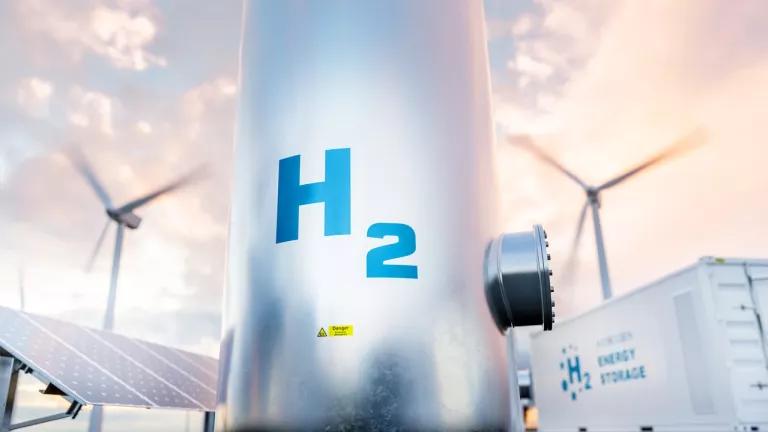Proposed Hydrogen Guidance Is Strong. But Backsliding Looms.
Proposed federal rules for hydrogen production will avoid dire climate and consumer impacts. But some industry groups and policymakers aim to weaken them.

Note: this blog zooms in on Treasury guidance for the electrolytic hydrogen production pathway. Forthcoming blogs will hone in on other production pathways.
Late in 2023, the Biden administration published highly anticipated proposed guidance for the IRA 45V clean hydrogen tax credits, the largest subsidy for clean hydrogen in the world projected to amount to hundreds of billions of U.S. taxpayer dollars. The proposal is cause for cheer and positions the U.S. alongside the European Union on the pedestal of climate-aligned hydrogen standards. The Biden administration fended off an onslaught of lobbying by energy incumbents and their proxies over the past year and put out guidance that conforms with an overwhelming base of supportive evidence, includes strong protections for the climate, electricity consumers and communities, and will scale a flourishing and truly clean U.S. hydrogen industry. The proposal will avoid hundreds of millions of tons of carbon emissions and electricity price spikes from hydrogen production. It also sets a sprint to success for the nascent clean hydrogen industry towards its best potential to bolster the clean energy transition and will help prevent hydrogen production from becoming a highly contested climate problem.
The proposal was met with a groundswell of support from a wide range of industry groups spanning the hydrogen value chain, academics, environmental groups, and consumer advocates.
But the bubbly should probably be kept on ice, as challenges loom. 2024 will see a fierce fight as the Biden administration finalizes guidance, with some industry groups and policymakers engaging in a pressure campaign to substantially weaken the final rules, with dire consequences for the climate, electricity consumers and the credibility of the nascent industry.

The 45V credits became a cause célèbre in 2023 and a subject of enormous interest, partly due to the high stakes directly linked to the hydrogen industry—it’s a lot of money and a lot of emissions on the table—and partly because its implications surpass hydrogen. The debate muddled together several high-stakes policy questions that are fundamental to the clean energy transition—including what it means to actually be powered by clean energy, global trade of industrial commodities and others.
Hydrogen is potentially set to play a key role in the clean energy transition by replacing fossil fuels in the hardest to clean up sectors like heavy industry and marine shipping. But the first step is ensuring that its production is squeaky clean. By defining how hydrogen is to be produced in the U.S., the 45V rules are therefore a major step on the arc of hydrogen deployment both in the U.S. and globally. By offering the most generous subsidies for clean hydrogen in the world, the U.S. will exert a major pull on global investment and become an incubator of clean hydrogen projects. Its hydrogen production rules will therefore have a defining impact on the emerging global clean hydrogen market.
The blog digs into the guidance toplines and its multidimensional benefits, and outlines some of the broad loopholes that the administration is considering in the final rules that could erode the benefits.
Proposed guidance embraces the “three pillars”, grounded in ironclad evidence.
Treasury grounds itself in a pile of evidence to assert that the three criteria of 1) additionality or “incrementality”, 2) hourly matching, and 3) deliverability are necessary to avoid substantial indirect emissions from hydrogen production in violation of the IRA emissions limits. NRDC agrees with this legal read. Treasury requires:
- Additionality, or “incrementality”, from day 1.
- Hourly matching starting in 2028, without locking in early weaker rules. And
- Solid deliverability requirements from day 1.
Apart from being legally necessary, the proposal is pragmatic and robustly substantiated. Incrementality ensures that hydrogen is produced in lockstep with clean energy deployment and that it does not compromise our number 1 tool to decarbonizing our electric grid—to keep existing clean electricity on the grid as opposed to diverted into hydrogen production. Similarly, the 2028 hourly matching phase-in date is very well substantiated and offers ample time for the necessary tools to scale. Deliverability is necessary to ensure that clean power is generated in the same grid or region where electrolytic hydrogen is being produced. The concept of deliverability is already a basic tenet of many state renewable energy portfolio standards.
Proposed guidance protects against emissions increases and a grim U-TURN on our climate goals.
An overwhelming evidence base has consistently shown that absent the three pillars, hydrogen production would drive hundreds of millions of tons of carbon emissions and a spike in electricity prices. This would violate IRA emissions thresholds and be a grim U-TURN for our clean energy transition.
To prevent those harmful consequences, a resounding chorus of industry groups, policymakers, environmental groups, consumer groups, academics, and environmental justice groups have urged the Biden administration to adopt the three pillars. Weaker rules would allow for textbook greenwashing, where hydrogen projects claim that they are powered by clean energy with some on-paper accounting, while in reality spurring fossil fuel generation on the grid to meet their demand.
The Rhodium Group has already assessed that Treasury’s proposal would help avoid substantial carbon emissions by 2035, and that any backsliding would erode emissions benefits.
Proposed guidance protects against power price increases.
Because electrolyzers are power hungry-- a large-scale hydrogen production facility could have similar electricity demand to a medium-sized city—they will add significant demand on the grid. If their demand is poorly managed—i.e., absent the three pillars—they will drive spikes in power prices. This harmful impact has been well documented. Cryptomining also offers a powerful precedent. Like electrolyzers, cryptomining is power hungry. It has increased utility bills by tens to hundreds of millions of dollars for households and businesses in upstate New York and led to costly grid strains in Texas. Some of the largest consumer groups in the U.S.—including in several hydrogen hub states— have urged the Biden administration to require the three pillars citing concerns that poorly managed electrolytic hydrogen production will drive electricity price increases for low- and moderate-income households and businesses. By embracing the three pillars, proposed Treasury guidance includes key protection for consumers, which are ever more necessary to avoid compounding already rising power prices.
Proposed guidance will support robust industry growth.
Despite the unfounded litany of claims from some industry groups, the proposed guidance will support substantial growth of a truly clean hydrogen industry. This is evidenced by the resounding choir of companies that came out in support of the proposal.
A range of companies building large-scale hydrogen projects and with more than a whopping 50 GW of electrolyzers under consideration sent a letter to the administration shortly before guidance came out expressing “confidence that proposed 45V guidance requiring the three pillars […] will support scaled industry growth and enable the creation of a successful U.S. and global clean electrolytic hydrogen market” and urging the administration to “be skeptical of claims that proposed strong guidance will kill the industry. This is demonstrably false.”
In fact, the bulk of first moving commercial scale projects in the U.S. and globally are set to be compliant with the 3 pillars, including in the European Union, where the project pipeline has been consistently growing since the bloc adopted the three pillars.
The companies’ position is further substantiated by the overwhelming majority of studies – by electrolyzer manufacturers, hydrogen and renewable developers, academics and objective research groups – finding three-pillar projects will be very cost-competitive from day one.
Both additionality and hourly matching will also incentivize job creation in the U.S. Additionality will require the creation of new jobs to construct new clean energy projects not already on the grid. Hourly matching will require new jobs to produce high quality, smart electrolyzers that can match on an hourly basis.
Proposed guidance will position the U.S. as a leader in advanced clean hydrogen technology.
Not all electrolyzer technology is the same. Hourly matching will require “smarter technology”—advanced, flexible electrolyzers that can vary operations with the availability of clean energy. This is precisely the type of technology that will be needed for hydrogen to play a role in our clean energy future where the availability of cheap, clean power will be variable. The EU is swiftly angling to become a major advanced electrolyzer manufacturing base. Weaker rules—notably annual matching—would garble that innovation signal and advantage “low-tech”, inefficient and inflexible electrolyzer technology. This is because annual matched projects do not need to fluctuate their operations with the availability of clean electricity and can instead operate close to 24/7. Annual matching will therefore kneecap efforts to develop an advanced U.S. electrolyzer manufacturing base.
By embracing hourly matching, the administration will also kick off a virtuous global cycle of innovation, whereby parallel U.S., EU, and other investments in cutting edge electrolyzer technology will turbocharge technology advancement and cost reductions.
But large loopholes loom and risk eroding the array of benefits.
The proposal however includes some concerning elements. The administration is considering broad loopholes for existing clean energy resources – notably nuclear and hydro plants—to participate in 45V. This is partly the product of fierce lobbying on the part of some industry players and policymakers aiming for maximum flexibility and to accommodate for energy assets of interest to them-- emissions, electricity consumers and industry credibility be damned.
The administration is considering allowing 5-10% of all existing clean power to count towards 45V compliance. This is huge. It is the equivalent of:
- Diverting 2-4% of total U.S. power for hydrogen production. This is approximately equivalent to the power consumption of the state of Oklahoma for the lower range, and Illinois for the upper range.
- Producing the equivalent of 15-30% of today’s total U.S. hydrogen production without any additionality requirement (by effectively plugging into the grid).
- 2-4x the total power consumption by cryptomining operations in the U.S., which have already driven emissions increases and power price spikes.
The Rhodium Group has already estimated that a blanket 5% allowance “could cause a huge increase in net systemwide emissions—up to nearly 1.5 billion metric tons of increased emissions cumulatively through 2035”. This is the equivalent of today’s annual U.S. power sector emissions.
NRDC and partners will be closely engaged on this piece over the next few months to ensure that any added flexibility in the final rules is surgical and does not act as a sledgehammer to the strong proposal.
The 45V Proposal is a Sprint to Success for the Industry. We Cannot Afford Any Backsliding.
We have little time to achieve our goal of a net-zero greenhouse gas economy by 2050, and urgently need to accelerate the clean energy transition. Truly clean hydrogen will play an important role in supporting this transition, but we cannot afford any detours and locking in ill-guided investments that will increase emissions and compromise the transition. The proposed 45V guidance is a sprint to success for the nascent clean hydrogen industry.
The Biden administration must hold firm and avoid offering blanket sledgehammer-like loopholes to energy incumbents looking for shortcuts to lucrative taxpayer funded subsidies with minimal effort. It’s time to stay the strong hydrogen course that ensures climate integrity and benefits the most diverse set of stakeholders.




